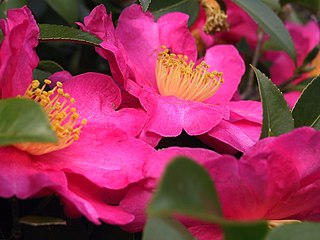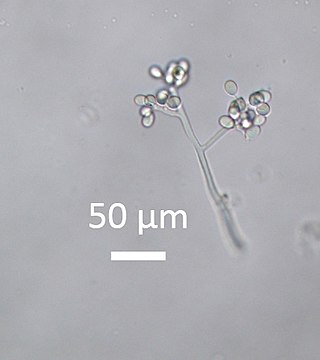Related Research Articles

Camellia is a genus of flowering plants in the family Theaceae. They are found in tropical and subtropical areas in eastern and southern Asia, from the Himalayas east to Japan and Indonesia. There are more than 220 described species. Camellias are popular ornamental, tea and woody-oil plants that have been cultivated throughout the world for centuries. To date, over 26,000 cultivars, with more than 51,000 cultivar names including synonyms, have been registered or published.

Camellia sinensis is a species of evergreen shrub or small tree in the flowering plant family Theaceae. Its leaves and leaf buds are used to produce the popular beverage tea. Common names include tea plant, tea shrub, and tea tree.

Stem rust, also known as cereal rust, black rust, red rust or red dust, is caused by the fungus Puccinia graminis, which causes significant disease in cereal crops. Crop species that are affected by the disease include bread wheat, durum wheat, barley and triticale. These diseases have affected cereal farming throughout history. The annual recurrence of stem rust of wheat in North Indian plains was discovered by Prof. K.C. Mehta. Since the 1950s, wheat strains bred to be resistant to stem rust have become available. Fungicides effective against stem rust are available as well.

Ug99 is a lineage of wheat stem rust, which is present in wheat fields in several countries in Africa and the Middle East and is predicted to spread rapidly through these regions and possibly further afield, potentially causing a wheat production disaster that would affect food security worldwide. In 2005 the noted green revolution pioneer Norman Borlaug brought great attention to the problem, and most subsequent efforts can be traced to his advocacy. It can cause up to 100% crop losses and is virulent against many resistance genes which have previously protected wheat against stem rust.
Pseudopestalotiopsis theae is a plant pathogen affecting tea.
Nigrospora sphaerica is an airborne filamentous fungus in the phylum Ascomycota. It is found in soil, air, and plants as a leaf pathogen. It can occur as an endophyte where it produces antiviral and antifungal secondary metabolites. Sporulation of N. sphaerica causes its initial white coloured colonies to rapidly turn black. N. sphaerica is often confused with the closely related species N. oryzae due to their morphological similarities.
Heterodera latipons, the Mediterranean cereal cyst nematode or wheat cyst nematode, is a plant pathogenic nematode.
Cherry mottle leaf virus (CMLV) is a plant pathogenic virus causing leaf rot. It is closely related to the peach mosaic virus.

Plasmopara is a genus of Oomycota. Plasmopara species are plant pathogens, causing downy mildew on carrot, parsley, parsnip, chervil, and impatiens.

Plant Disease is a peer-reviewed scientific journal of plant pathology focusing on new diseases, epidemics, and methods of disease control. It is a continuation of The Plant Disease Bulletin (1917–1922) and The Plant Disease Reporter (1923–1979), both publications of the US Department of Agriculture. It is currently published by the American Phytopathological Society and edited by Mary Burrows.
Phytophthora hydropathica is an oomycete plant pathogen that is found in aquatic environments such as irrigation and river water. The pathogen was previously classified as P. drechsleri Dre II before being categorized as its own distinct species. P. hydropathica has been primarily found in association with ornamental plant nurseries. The pathogen has been isolated throughout the Southern United States, as well as internationally in Mexico, Italy, and Spain.
Curvularia inaequalis is a plant saprobe that resides in temperate and subtropical environments. It is commonly found in the soils of forage grasses and grains. The species has been observed in a broad distribution of countries including Turkey, France, Canada, The United States, Japan and India. This species is dematiaceous and a hyphomycete.

Pyraclostrobin is a quinone outside inhibitor (QoI)-type fungicide used in agriculture. Among the QoIs, it lies within the strobilurin chemical class.

Bitter rot of apple is a fungal disease of apple fruit that is caused by several species in the Colletotrichum acutatum and Colletotrichum gloeosporioides species complexes. It is identified by sunken circular lesions with conical intrusions into the apple flesh that appear V-shaped when the apple is cut in half through the center of the lesion. It is one of the most devastating diseases of apple fruit in regions with warm wet weather.
Epicoccum sorghinum is an ascomycete fungus with known plant pathogenicity to sugarcane and rice, causing ring spot disease and leaf spot disease. This fungus is primarily known for its production of tenuazonic acid, which leads to complications with growth and causes the symptoms of leaf spot disease. Tenuazonic acid not only affects plant growth, but has recently been proven to impact human health due to its prevalence in food and beverages. It is widely dispersed, affecting multiple hosts in different countries. Although not a serious threat, Epicoccum sorghinum has been known to influence the sorghum grain-mold complex in ways which reduce crop yields, seed viability, and kernel weight. As a result of continuous phylogenetic and morphological discoveries relevant to Epicoccum sorghinum, this fungus has undergone a number of name changes.

The Sporocadaceae are a family of fungi, that was formerly in the order Xylariales. It was placed in the Amphisphaeriales order in 2020.
Pseudopestalotiopsis is a genus of plant pathogens in the family Sporocadaceae.
References
- 1 2 3 4 5 6 7 8 9 10 11 12 13 14 15 16 17 18 19 20 21 22 23 24 25 26 27 28 Pandey, Abhay K.; Sinniah, Ganga D.; Babu, Azariah; Tanti, Amarjyoti (2021-08-04). "How the Global Tea Industry Copes With Fungal Diseases – Challenges and Opportunities". Plant Disease . American Phytopathological Society: PDIS–09–20–1945. doi: 10.1094/pdis-09-20-1945-fe . ISSN 0191-2917.
- 1 2 3 4 5 6 Keith, Lisa; Ko, Wen-Hsiung; Sato, Dwight M.; University of Hawai'i at Mānoa. Identification Guide for Diseases of Tea (Camellia sinensis), Plant Disease, October 2006.
- ↑ Zheng, Shiqin; Chen, Ruiqi; Wang, Zhe; Liu, Juan; Cai, Yan; Peng, Minghui; Zhang, Tian; Li, Yunxi; Wang, Baohua; Bao, Jiandong; Zhang, Dongmei; Wang, Zonghua; Hu, Hongli (2021). "High-Quality Genome Assembly of Pathogenic Pseudopestalotiopsis theae, the Pathogenic Fungus Causing Tea Gray Blight". Plant Disease. 105: 3723–3726. doi: 10.1094/PDIS-02-21-0318-A .